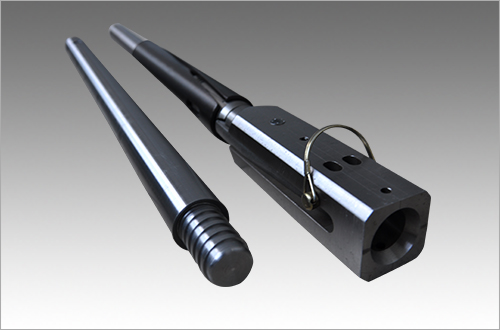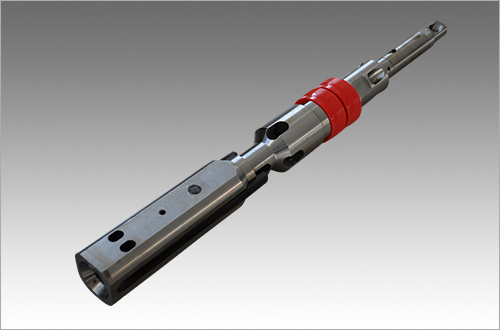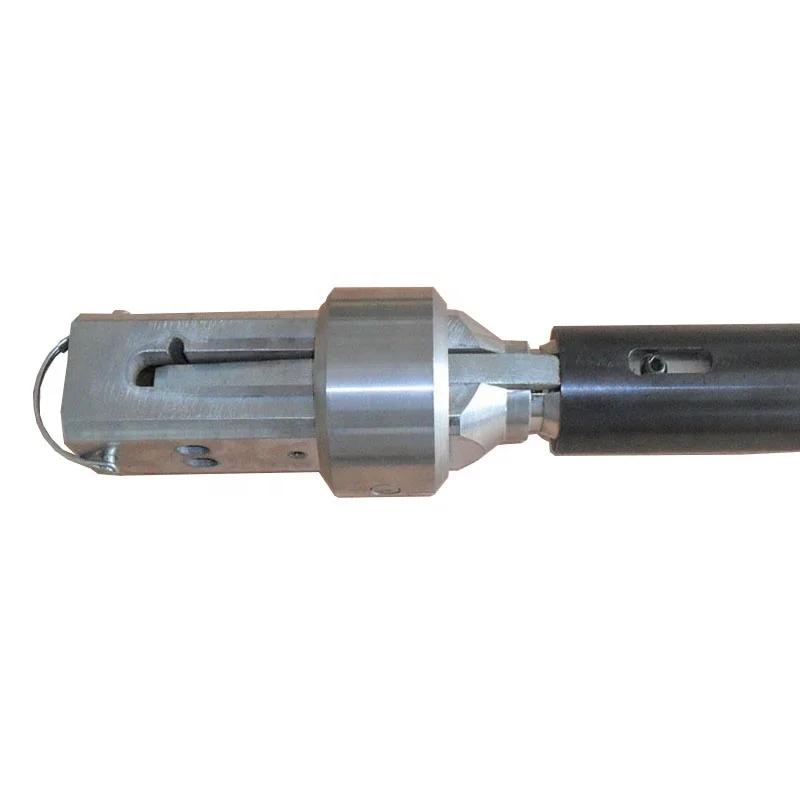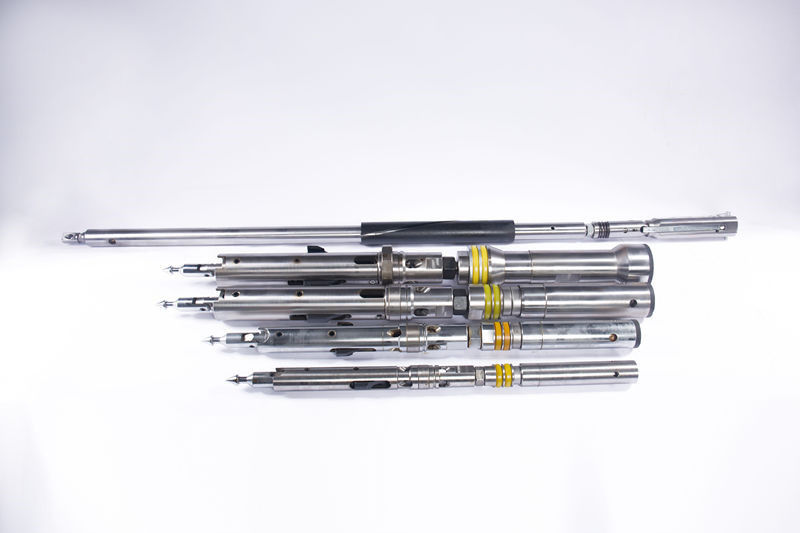wireline overshot pricelist

Baoji Ruixin Energy Equipment Co., Ltd. was established in 2012. It is an IS0: 9001-2015 and API Q1 system certified technology research and development organization specializing in the design and manufacture of steel wire, cable and coiled tubing tools. With strong new product research and development capabilities, it has obtained 12 national utility model patent certificates and 1 invention patent certificate. Undertook two prefecture-level and provincial-level scientific research projects. Our products include wireline wireline wellhead blowout prevention equipment, wireline downhole tools and coiled tubing downhole tools. At present, we have provided professional equipment and technical support to more than 50 oilfield service companies in various regions at home and abroad.

PARVEEN Wireline Overshots are used retrieve a fish lost in the well that does not have a conventional fishing neck or a damaged fishing neck on it. The tool is operated by applying the weight of the tool string on to the fish. This will allow the slips to expand around the fish when the tool string is picked up, the slip will engage the fish. These are non releasable type overshots.
WIRELINE OVERSHOTS Max O.D. Part No. F/N O.D. Top To Catch Part No. (in) (in) Connection Dias (in) 0.50 - 0.75 351721 - 07 1.750 351721 1.375 15/16 - 10 UN 0.75 - 1.00 351721 - 10 1.00 - 1.25 351721 - 12 0.50 - 0.75 352632 - 07 0.75 - 1.00 352632 - 10 2.625 352632 1.750 1-1/16 - 10 UN 1.00 - 1.25 352632 - 12 1.25 - 1.50 352632 - 15 1.50 - 1.75 352632 - 17 WIRELINE OVERSHOT 1.75 - 2.00 352632 - 20 0.50 - 0.95 353846 -09 0.95 - 1.40 353846 - 14 3.800 353846 2.312 1-9/16 - 10 UN 1.40 - 1.85 353846 - 18 1.85 - 2.30 353846 - 23 2.30 - 2.75 353846 - 27
PARVEEN Releasable Overshots are used retrieve a fish lost in the well that does not have a conventional fishing neck or a damaged fishing neck on it. The tool is operated by applying the weight of the tool string on to the fish. This will allow the slips to expand around the fish when the tool string is picked up, the slip will engage the fish. Many overshots cannot be released once they are latched. However the slips of the PARVEEN releasable overshots can be released by downward jarring.
RELEASABLE OVERSHOTS O.D. F/N. O.D. Top Slip Range Part No. (in) (in) Connection (in) 1.875 1.375 15/16 - 10 UN 0.50-1.50 R351921RELEASABLE 2.250 1.375 15/16 - 10 UN 0.50-1.75 R352221 OVERSHOT 2.625 1.750 1-1/16 - 10 UN 0.50-2.00 R352632 3.800 2.313 1-9/16 - 10 UN 0.50-2.75 R353846

In U.S. Pat. No. 3,120,283 to Braun there is disclosed a core barrel inner tube assembly having an overshot coupling portion retained in a position by the latches in their retracted position to prevent fluid bypass until the latches move to their seated position and thence under gravity or inward fluid pressure move to permit fluid bypass and prevent the latches moving to their retracted position until the coupling portion is retracted; and a fluidly propellable overshot assembly. Also it is old to provide a core barrel inner tube assembly that is similar to that of the second embodiment of U.S. Pat. No. 3,333,647 to Karich except that the spearpoint plug has an annular fluid seal member with a bypass channel that includes an outer port opening outwardly of the seal member and an inner port that is blocked by the latch release tube when the plug is in its inner position relative to the tube, and resilient means to urge the release tube inwardly relative to the latch body to the release position. The plug is mechanically forced to its bypass open position when the release tube moves inwardly.
U.S. Pat. No. 3,266,835 to Hall discloses a core barrel inner tube assembly fluidly propellable in any direction and includes a valve assembly connected to a spearhead and resiliently urged to a position to block fluid flow. When the inner tube assembly moves to its inner position, water pressure forces the spearhead assembly to move to open a bypass channel and allow the latches to move to a latch seated position. If the latches do not seat properly a valve is not opened and bypass is blocked. French Patent No. 2,014,485 discloses a first embodiment of a latch that has an axial outer hook portion for couplingly engaging an overshot assembly and an inner hook portion extending transversely in the opposite direction from that of the hook portion for coupling engaging a latch seat while the second embodiment has an outer hook portion for couplingly engaging an overshot assembly and an outer portion for engaging a latch seat, both of which are outwardly of the latch pivot. U.S. Pat. No. 3,701,389 to Egnelov et al also discloses some of the same structure as disclosed in the French patent. U.S. Pat. No. 1,427,268 to Dodd discloses outer latches to block outer movement of the core barrel inner tube assembly and inner latches to block inward movement when in the core collecting position.
A core barrel inner tube assembly that includes a latch body portion pivotally mounting a latch for movement between a retracted position and a latch seated position, an axially elongated portion extending axially relative to the latch body portion for defining a fluid bypass channel, valving mechanism extending within the channel that is movable between a first position substantially blocking inward flow through the channel and a second position providing a fully open fluid channel, valve control mechanism that is movable relative to the latch body and elongated portion for moving the valving mechanism from the valving mechanism second position after the latch has moved from its retracted position to its latch seated position with the assembly at the bit end of a drill string and inward fluid pressure has been significantly decreased from that previously applied. In one embodiment the valving mechanism is at least in part retained in its first position by the valve control moving mechanism which in turn is prevented from moving the valving mechanism by abutting against the latch in the latch retracted position. In another embodiment the valving mechanism and the elongated portion are of a construction that the valving mechanism is moved inwardly from a fluid channel open position to the valving mechanism blocking position by inward fluid flow when the bore hole extends upwardly in an inward direction. Advantageously the last mentioned embodiment has a latch with an overshot hooking portion and a foot on the opposite axial side of a latch pivot to extend transversely outwardly in the same direction with the foot being abuttable against the valve control mechanism to prevent the valve control mechanism moving the valving mechanism to its second position until the latch moves from its retracted position to the latch seated position.
One of the objects of this invention is to provide a new and novel core barrel inner tube assembly that requires its latch moving to its latch seated position and a substantial decrease of inward fluid pressure applied to the assembly before a fluid bypass channel fully opens for inward bypass fluid flow. In furtherance of the above object, it is another object of this invention to provide an assembly that is fluidly propellable inwardly regardless of the direction of extension of the bore hole. Another object of this invention is to provide in a core barrel assembly new and novel means for blocking inward fluid bypass until the assembly latch means moves to its latch seated position and retains the latch means in the latch means seated position until the assembly is retracted by an overshot device.
FIGS. 5 and 6 when arranged with their axial center lines aligned and lines D--D aligned form a composite longitudinal view through an overshot assembly and the outer end portion of the core barrel inner tube assembly of FIG. 1 other than the inner tube assembly is shown in its retrieval position just after the latches have been retracted;
The latch axially elongated outer parts 38 are integrally joined to feet 37 which extend further radially outwardly relative the central axis M-M of the inner tube assembly than the axially adjacent parts of parts 38. The parts 38 are integrally joined to axially elongated latch intermediate portion to form radial outward, downwardly facing shoulders 40. Integrally joined to the outer ends of portions 39 are radially narrow neck parts 36 of latch outer portions 35, 36 that are of radial dimensions substantially smaller radial dimensions than portions 39 whereby portions 39 have radial and axial outer corner portions seatable in the recess 21a in abutting relationship to the inner edge of the lock coupling. Latch outer end portions 35, 36 include overshot engagable end (hook) parts 35 that are integrally joined to the outer ends of parts 36 and are of grater radial dimensions than parts 36 to form radial outer, inwardly facing shoulders 43. Parts 35 have axial beveled edges 35a that radially diverge in an axial inward direction. Parts 35 are located in the outer end portion of slots 27 and extend further radially outwardly of the central axis M--M than parts 36. Hardsurface parts 29b are provided on parts 29.
As may be seen from FIGS. 1 and 12, the outer portion of head 30a has an outer frustoconcial part which has an inner major base that is of at least substantially the same dimension as the minimum spacing of edges 35a when the latches are in an extended positon to facilitate the overshot assembly, generally designated 44 (FIGS. 1, 5 and 6) couplingly engaging the latches when the overshot assembly is moved inwardly relative to the latches and the latches are in their latch seated position.
Referring to FIGS. 5 and 6, the overshot assembly, generally 81, that may be used to retract the first embodiment of the inner tube assemble, includes a swivel subassembly 82 to which the wire line cable 80 is attached. The subassembly is threadedly mounted by the outer end of the overshot body 83, the intermediate portion of which has an axially elongated bore 84 that at one end opens through ports 85 exterior of the body 83 and at the inner end opens through inner ports 86 exterior of the reduced diameter, inner end portion of the body. A resilient shut off valve 87 is retained in abutting relationship to an axially inwardly facing shoulder of body 83 by adjusting nuts 88 threaded on the body reduced diameter portion. The shut off valve forms a close fit with the inner peripheral wall of the drill string with ports 85, 86 and bore 84 forming a bypass channel that opens on axially opposite sides of the shut off valve and nuts 88. O-rings 89 are mounted in annular grooves on axially opposite sides of ports 86.
The overshot body is provided with axially elongated slots 90 inwardly of ports 86 into which a transverse pin 93 is slidably extended. A latch coupling tube 98 is slidably extended over the reduced diameter inner end portion of the overshot body, the tube mounting the pin 93 in a fixed position relative thereto. A compression spring 94 has one end abutting against pin 93 and an opposite end abutting against a set screw 95 threaded into the inner end of bore 96 to, through pin 93, resiliently urge the coupling tube outwardly relative to the overshot body. The axial movement of the coupling tube relative to the overshot body in one direction is limited to a position ports 86 are unblocked by the pin 83 abutting against the inner ends of slots 90, and in the opposite direction to a position ports 86 are blocked by the coupling tube with the pin abutting against the opposite ends of the slots. The coupling tube has an internal flange 98a providing an outwardly facing shoulder 100 and a bore 98b that opens to bore 98c and of a diameter that is sufficiently great to have the latch body part 30a pass therethrough.
When the inner tube is filled with core the shut off member 71b is squeezed to expand radially to provide a high pressure signal at the surface as is conventional, member 71b being a part of the spindle assembly 71. The overshot assembly 44 or another appropriate overshot assembly is inserted into the drill string and pumped inwardly. As the overshot assembly is pumped inward the spring 94 retains the coupling tube 98 relative to the overshot body to block ports 86 and in conjunction with valve member 87 prevents any significant inward fluid flow past the overshot assembly. Of course if the drilling direction is downwardly, a non-fluidly propellable overshot assembly having an inner end such as shown in FIG. 6 can be used.
Due to the inner diameter of the tubular member legs 55b being greater than the maximum diameter of the overshot bore portion 96a and less than the outer diameter of the coupling member, as the flange 98 passes inwardly of latch body head part 30a, the flange abuts against the legs to move the tubular member 55 inwardly relative to the latch body and against the resilient force of spring 56 sufficiently the latch feet are movable into the slots 62. Thereafter the flange abuts against the beveled surface 44a of the latches to move the latches from their latch seated position. Upon the flange moving inwardly of latch portions 35, the outer ends of the latches are spring urged away from one another such that shoulders 43 are at least in part directly axially outwardly of annular shoulder 100 of the flange. The inward movement of the overshot assembly is limited by the flange 98a abutting against the outer, generally transverse edges of latch parts 39. While the tubular member is moved inwardly and the latch portions are moved toward one another, the latch feet 37 move into slots 62.
Now upon retracting the overshot assembly the overshot body is moved relative to the coupling tube to open the overshot bypass channel. Thence the coupling tube is retracted, the latch body being retracted therewith. The feet in extending into slots 62 prevent the tubular member moving inwardly relative to the latch sufficiently to permit the valving mechanism moving to fully block the bypass channel of the inner tube assembly.
After the core receiving tube is filled and the shut-off valve 158 is compressed to provide a pressure signal at the surface, a conventional wire line overshot assembly is pump-in or allowed to free fall, depending on the drilling direction and the drilling conditions. Upon the overshot assembly coupling onto spearpoint plug portion 207a, the initial retraction of the spearpoint plug through the cylinder tube retracts pin 189 to abut against the outer edges of the slots 190. Further retraction moves the latch release tube and thereby pin 177 to be axially inwardly of the outer latch portions 175. Thereupon the inner beveled edges that in part define slots 174 abut against the beveled edges of the outer portions of the outer latches to pivot the outer latches to their retracted position. After the outer latches have been retracted and pin 177 abuts against the outer ends of the latch body slots 178, further retraction of the overshot assembly results in pin 177 moving the latch body outwardly, and upon the outer diagonal edges 162c abutting against the axial outer edge of the latch seat, the latches 162a, 162b are pivoted to their retracted position. The outward movement of the latch body retracts the structure attached thereto and extending inwardly thereof.
During the time the overshot assembly moves toward the spearpoint subassembly and as it retracts the spearpoint subassembly the valve ball remains in the dotted line position of FIG. 13 so that the bypass channel remains open.

Offering you a complete choice of products which include Segmented Saw Blade, Wireline Diamond Core Bit, Thin Wall Bit Core Drills, PDC Non Coring Bit, Thin Wall Diamond Bit and Rotary Drilling Equipment.
We are actively engaged in manufacturing, exporting and supplying an extensive range of Wireline Diamond core Bit that is widely used for geological exploration, mineral exploration, etc. Offered diamond bit is manufactured using quality assured raw material in compliance with set industry standards under the supervision of our adroit professionals. Owing to its various qualitative features, our provided diamond bit is widely appreciated by our esteemed clients.

An OVERSHOT is attached to the end of a wireline and lowered into the outer tube. The Overshot then locks on to the Latch Head Assembly at the top of the core barrel.
The inner tube is then pulled to the surface with the core sample inside. Givens International offers an overshot for a spear point or quad latch head.

Overshot is a necessary device in wireline drilling. It"s dropped on a cable and directly couples onto and lift up the inner tube assembly, eliminating the need to couple and uncouple the rod string each time the core is retrieved.
Ezy Lock Overshot is a modified product based on compact overshot. It protects against accidental release of the core barrel. This is ideal for suface application when hoisting above ground.
Overshot is a key component of wire-line coring systems. To retrieve the core sample, the overshot is lowered into the hole on a wire cable until it comes in contact with the spearhead point on the head assembly. Positive latching lifting dogs securely attach, and the inner tube assembly is pulled from the hole to retrieve the core.




 8613371530291
8613371530291